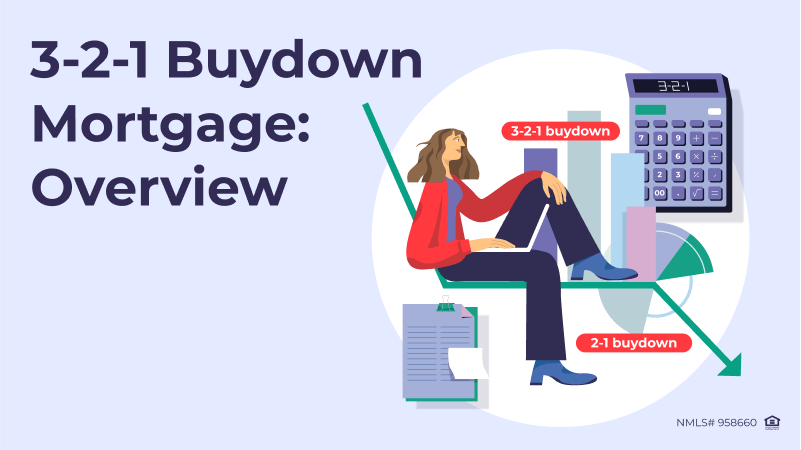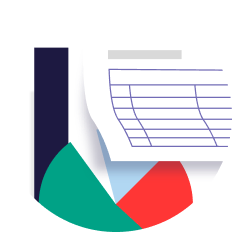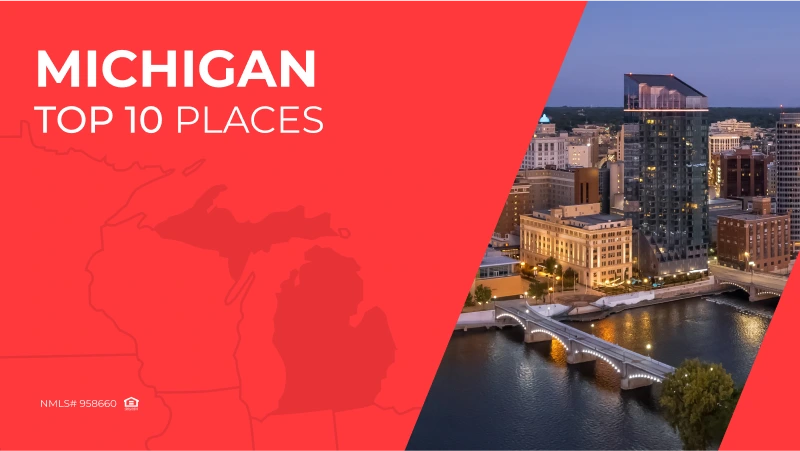The 3-2-1 buydown mortgage reduces the interest rate for the initial three years of the loan, providing significant initial savings and easing the financial burden for new homeowners. The interest rate decreases by three percentage points in the first year, two points in the second year, and one point in the third year before returning to the original rate in the fourth year.
This structure is particularly advantageous in a fluctuating economic environment, where buyers might benefit from lower payments as they adjust to homeownership costs and possibly higher interest rates in the future. In this article, we’ll take a closer look at what 3-2-1 buydown is.
What is a 3-2-1 Buydown Mortgage?
Looking for a suitable loan program?
Choose among 20+ programs and get
a detailed loan calculation
Loan Calculator
Programs
A 3-2-1 buydown mortgage is a financing arrangement that temporarily lowers the interest rates on a home loan, making it easier for buyers to afford payments in the initial years of homeownership. This type of mortgage provides a stepped reduction in interest rates for the first three years, followed by a return to the standard rate established at the time of loan origination.
Here’s how the rate structure works: In the first year of the mortgage, the interest rate is reduced by three percentage points lower than the normal rate. The rate decreases by two percentage points in the second year and by one percentage point in the third year. By the fourth year, the interest rate adjusts back to the original rate agreed upon at the start of the mortgage.
This setup benefits buyers by easing the financial burden during the initial, often more challenging years of mortgage payments. It allows homeowners to settle into their new property and manage other expenses without the pressure of higher mortgage payments. An upfront payment, typically funded by the home seller or the builder, makes the initial lower payments possible by covering the difference in interest. This arrangement not only helps buyers but also makes properties more attractive in competitive real estate markets.
After the buydown period, homeowners must prepare for the increase in their monthly payments, as rates revert to the standard level.
How Does a Buydown Mortgage Work?
A 3-2-1 mortgage rate buydown significantly eases the financial burden for homebuyers during the first few years of a mortgage by systematically reducing the interest rates. This detailed explanation will explore how buydowns work over the three-year period and what happens once the buydown period concludes.
Rate Reduction Mechanics
In a 3-2-1 buydown, the lender reduces the interest rate in a staggered fashion over the initial three years of the mortgage, giving the borrower a temporary discount on their monthly payments. However, it does not impact the loan amount. The seller or the builder generally funds this reduction as an incentive to make the property more appealing or to facilitate a quicker sale.
- First Year. The interest rate decreases by three percentage points below the loan’s permanent rate. For example, if we agree on a permanent rate of 6%, we would reduce the rate to 3% for the first year. The large decrease in payment allows the homeowner to save money or use it for other purposes. They can use the saved money for fixing up the house or buying furniture.
- Second Year. The discount decreases to two percentage points below the permanent rate. Following the previous example, the rate would adjust to 4%. This gradual step-up prepares the homeowner for the eventual transition to the full rate, while still providing relief from the standard payment amount.
- Third Year. The rate is reduced by one percentage point in the third year. Continuing with the same scenario, the interest rate would increase to 5%. This rate is closer to the permanent rate, easing the homeowner into the standard payment structure.
Post-Buydown Period Transition
After three years, the interest rate for your home loan will go back to the original rate you agreed on. This rate will stay the same for the rest of your loan, unless you refinance. In the fourth year, your monthly payments will increase to 6%.
This might be a big change, so it’s important to plan ahead and save money. The lower payments in the beginning can help you prepare for this increase and make sure you can still afford your home comfortably.
Benefits of a 3-2-1 Buydown Mortgage
Struggling with
a loan scenario?
Get a solution in 30 minutes! Fill out
the short form and get your personal offer
Submit a Scenario
The 3-2-1 buydown mortgage offers distinct advantages, both immediate and long-term, making it an attractive option for many homebuyers, especially in a high-interest rate environment. Here’s how these benefits break down:
A 3-2-1 buydown mortgage offers the benefit of lower monthly payments for the first three years. This can be helpful for new homeowners who need some time to get their finances in order after buying a house.
During the first year, your payments will be three points less than the permanent rate. Each following year, it decreases by one point. This means you could save a lot of money during those first few years that you can use for things like buying furniture, moving costs, or saving up money.
Long-term Advantages in a High-Interest Rate Environment
When interest rates are high or going up, getting a mortgage with a 3-2-1 buydown can be very helpful. This means you get a fixed rate when you sign the agreement, so you don’t have to worry about rates changing. Even when the buydown period is over, your fixed rate will still be lower than what it would be if you waited and got a mortgage then. This is especially good if rates keep going up because your fixed rate stays valuable while others might go even higher.
Plus, during that time of lower payments in the beginning, you could invest that extra money to make more money later. That way, when your payments go up after three years, it won’t feel like such a big change because you’ll have more money coming in from other investments. It’s all about making smart choices and planning!
Potential Drawbacks
While a 3-2-1 buydown mortgage can offer significant advantages, it’s essential to consider potential drawbacks, particularly regarding future financial challenges and the necessity for careful planning and foresight.
Future Financial Challenges
One thing that can be difficult with a 3-2-1 buydown mortgage is that your monthly payments will go up after the first three years. Even though you had lower interest rates at first, they will gradually increase until they reach the original rate. This could be a big change and make it harder for you to pay your bills if your income hasn’t gone up too. Also, if the housing market gets worse, you might owe more on your mortgage than what your home is worth. This can cause problems if you need to sell or refinance during this time.
Importance of Planning and Foresight
To avoid these risks, it is important to plan carefully and think ahead. Buyers should make sure they have a stable income in the future and enough money saved up for when their payments may go up. They should also think about how their finances may change in the future and how the housing market could affect them. Knowing all of this before getting a 3-2-1 buydown mortgage can help prevent any financial problems down the road.
So, while there are many benefits to a 3-2-1 buydown, it’s important to consider all factors before making a decision. Proper financial planning and understanding the terms of the mortgage are crucial for anyone thinking about this type of financing.
Who Typically Offers a 3-2-1 Buydown Mortgage?
DSCR loans:
Grow your portfolio!
- DSCR as low as 0
- No income and no employment needed
- Fastest turn times in the industry
Submit Your Scenario Today
Sellers, builders, and mortgage lenders typically offer a 3-2-1 buydown mortgage. Each plays a unique role in facilitating this type of mortgage arrangement, often motivated by different objectives.
Sellers may offer a 3-2-1 buydown as an incentive to attract buyers in a competitive market or to expedite the sale of their property. By offering to temporarily reduce the mortgage rate, sellers can make their property more affordable in the short term, appealing to a broader range of buyers who might be concerned about initial affordability.
Builders often use 3-2-1 buydown mortgages as a marketing tool to sell new construction homes. Like sellers, builders find that providing such financial incentives can significantly attract buyers who might otherwise be hesitant to bear the costs associated with purchasing a new home, especially in uncertain economic times.
Mortgage lenders also participate in offering 3-2-1 buydowns as part of their mortgage product portfolios. By doing so, they cater to borrowers seeking flexible financing solutions and help facilitate deals that might be less likely without such incentives. Lenders work with buyers, and sometimes in partnership with sellers or builders, to structure these loans in a way that balances the financial risks while making homeownership more accessible.
In each case, the common goal is to make property ownership more attainable and appealing, which benefits all parties involved.
Comparing 3-2-1 Buydowns to Other Mortgage Options
When considering mortgage options, buyers often compare the 3-2-1 buydown with other types of mortgages and buydowns to determine which best suits their financial needs and circumstances. Understanding the differences and how each option aligns with individual financial strategies is crucial.
Comparison with Other Mortgage Types
Standard Fixed-Rate Mortgages offer stability as the interest rate remains constant throughout the life of the loan, providing predictable monthly payments. This contrasts with a 3-2-1 buydown, where the rate starts lower but increases to a preset rate after three years. Fixed-rate mortgages are preferable for those who value consistency and long-term budgeting.
Adjustable-Rate Mortgages (ARMs), like buydowns, offer initial lower rates. However, unlike the 3-2-1 buydown that transitions to a fixed rate, ARMs can fluctuate based on market conditions, which might result in higher rates than those initially reduced in a buydown. ARMs are suitable for those who plan to move or refinance before rates climb.
Other Buydown Options, such as the 2-1 buydown, also offer temporary reduced rates but with a different structure. The 2-1 buydown only lowers the rates for two years instead of three and typically involves a lesser total rate reduction compared to the 3-2-1. This might be more suitable for those who anticipate a quicker financial upturn.
Advice on Choosing the Right Mortgage Type
When choosing between a 3-2-1 buydown and other mortgage options, consider your financial outlook and stability. Here are a few tips:
- Financial Stability. If you expect your income to increase or stabilize enough to manage higher payments in a few years, a 3-2-1 buydown could be beneficial due to the initial lower payments. However, if you prefer predictability and long-term stability, a fixed-rate mortgage might be better.
- Market Conditions. In a high-interest rate environment or when rates are expected to rise, locking in a rate with a fixed-rate mortgage after the buydown period can shield you from future increases. Conversely, in a declining rate environment, an ARM could potentially save more in the long run.
- Homeownership Duration. Consider how long you plan to stay in the home. If you’re not planning to stay beyond a few years, an ARM or a shorter-duration buydown might be more cost-effective. For long-term stays, the stability of a fixed-rate mortgage after a buydown period or a standard fixed mortgage might be more advantageous.
Ultimately, the right mortgage type depends on your individual financial circumstances, market conditions, and personal preferences. Consulting with a financial advisor or a mortgage broker can provide personalized insights and help make an informed decision tailored to your situation.
Is 3-2-1 Buydown Mortgage Right for You?
Deciding whether a 3-2-1 buydown mortgage is suitable involves careful consideration of several factors. This choice can significantly impact both the short-term affordability and long-term financial planning for potential homeowners. Here are key factors to evaluate:
Factors to Consider
Financial Forecast. Assess your expected financial situation over the next few years. If you anticipate a stable increase in income or improved financial circumstances, the initial lower payments of a 3-2-1 buydown can provide breathing room, with readiness for higher payments in later years.
Interest Rates Environment. Consider the current and projected interest rates. In a high-interest rate environment, locking in a lower rate now, even if it’s temporary, might save considerable money compared to other options that could expose you to rising rates.
Homeownership Goals. Reflect on how long you plan to stay in the home. If you expect to move or refinance before the buydown period ends, you may benefit more from the initial lower payments without the impact of higher rates later.
Advice for Brokers and Borrowers
Brokers should thoroughly understand their clients’ financial situations and goals to recommend the most appropriate mortgage type. Transparency about the implications of the rate increases after the buydown period is essential.
Borrowers need to approach this decision with a clear understanding of their current budget, future financial prospects, and the potential risks of higher future payments. It’s advisable to consult with financial advisors to evaluate how different mortgage options align with long-term financial goals. Refinancing the borrowers existing loan, may increase total finance charges over the life of the loan.
Ultimately, a 3-2-1 buydown mortgage can be an excellent option for those who are looking for initial payment relief with a plan to accommodate higher rates in the future. This requires a blend of financial prudence and strategic planning to ensure that when the introductory rate period ends, the transition to higher payments is manageable.
Conclusion
The 3-2-1 buydown mortgage offers an attractive solution for homebuyers seeking initial financial relief with a structured plan for future payments. By providing reduced interest rates in the first three years, this mortgage type eases the financial burden on new homeowners, allowing them to grow into their mortgage payments gradually. Borrowers need to consider their long-term financial stability and the market conditions when choosing this mortgage type. For personalized advice and to explore if a 3-2-1 buydown mortgage fits your financial scenario, A&D Mortgage is here to help.
Ready to take the next step? Visit the A&D Mortgage website today to learn more about the benefits of a 3-2-1 buydown mortgage and how it can be tailored to your financial needs. Start your mortgage application process with us, and let us help you secure your dream home with confidence. Your new home awaits—let’s make it happen!






